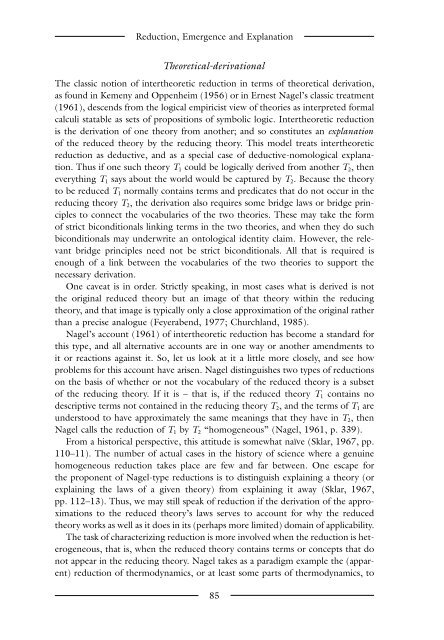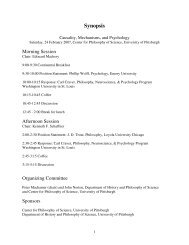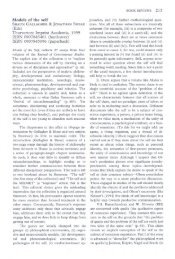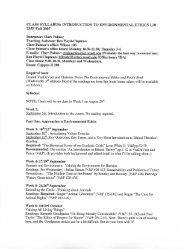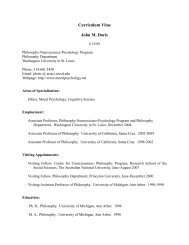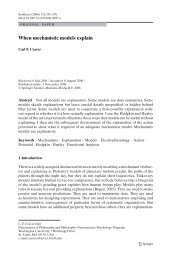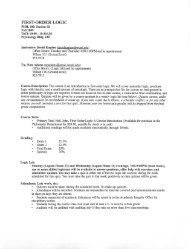The Blackwell Guide to the Philosophy of Science - The Department ...
The Blackwell Guide to the Philosophy of Science - The Department ...
The Blackwell Guide to the Philosophy of Science - The Department ...
You also want an ePaper? Increase the reach of your titles
YUMPU automatically turns print PDFs into web optimized ePapers that Google loves.
Reduction, Emergence and Explanation<br />
<strong>The</strong>oretical-derivational<br />
<strong>The</strong> classic notion <strong>of</strong> inter<strong>the</strong>oretic reduction in terms <strong>of</strong> <strong>the</strong>oretical derivation,<br />
as found in Kemeny and Oppenheim (1956) or in Ernest Nagel’s classic treatment<br />
(1961), descends from <strong>the</strong> logical empiricist view <strong>of</strong> <strong>the</strong>ories as interpreted formal<br />
calculi statable as sets <strong>of</strong> propositions <strong>of</strong> symbolic logic. Inter<strong>the</strong>oretic reduction<br />
is <strong>the</strong> derivation <strong>of</strong> one <strong>the</strong>ory from ano<strong>the</strong>r; and so constitutes an explanation<br />
<strong>of</strong> <strong>the</strong> reduced <strong>the</strong>ory by <strong>the</strong> reducing <strong>the</strong>ory. This model treats inter<strong>the</strong>oretic<br />
reduction as deductive, and as a special case <strong>of</strong> deductive-nomological explanation.<br />
Thus if one such <strong>the</strong>ory T1 could be logically derived from ano<strong>the</strong>r T2, <strong>the</strong>n<br />
everything T1 says about <strong>the</strong> world would be captured by T 2. Because <strong>the</strong> <strong>the</strong>ory<br />
<strong>to</strong> be reduced T 1 normally contains terms and predicates that do not occur in <strong>the</strong><br />
reducing <strong>the</strong>ory T 2, <strong>the</strong> derivation also requires some bridge laws or bridge principles<br />
<strong>to</strong> connect <strong>the</strong> vocabularies <strong>of</strong> <strong>the</strong> two <strong>the</strong>ories. <strong>The</strong>se may take <strong>the</strong> form<br />
<strong>of</strong> strict biconditionals linking terms in <strong>the</strong> two <strong>the</strong>ories, and when <strong>the</strong>y do such<br />
biconditionals may underwrite an on<strong>to</strong>logical identity claim. However, <strong>the</strong> relevant<br />
bridge principles need not be strict biconditionals. All that is required is<br />
enough <strong>of</strong> a link between <strong>the</strong> vocabularies <strong>of</strong> <strong>the</strong> two <strong>the</strong>ories <strong>to</strong> support <strong>the</strong><br />
necessary derivation.<br />
One caveat is in order. Strictly speaking, in most cases what is derived is not<br />
<strong>the</strong> original reduced <strong>the</strong>ory but an image <strong>of</strong> that <strong>the</strong>ory within <strong>the</strong> reducing<br />
<strong>the</strong>ory, and that image is typically only a close approximation <strong>of</strong> <strong>the</strong> original ra<strong>the</strong>r<br />
than a precise analogue (Feyerabend, 1977; Churchland, 1985).<br />
Nagel’s account (1961) <strong>of</strong> inter<strong>the</strong>oretic reduction has become a standard for<br />
this type, and all alternative accounts are in one way or ano<strong>the</strong>r amendments <strong>to</strong><br />
it or reactions against it. So, let us look at it a little more closely, and see how<br />
problems for this account have arisen. Nagel distinguishes two types <strong>of</strong> reductions<br />
on <strong>the</strong> basis <strong>of</strong> whe<strong>the</strong>r or not <strong>the</strong> vocabulary <strong>of</strong> <strong>the</strong> reduced <strong>the</strong>ory is a subset<br />
<strong>of</strong> <strong>the</strong> reducing <strong>the</strong>ory. If it is – that is, if <strong>the</strong> reduced <strong>the</strong>ory T1 contains no<br />
descriptive terms not contained in <strong>the</strong> reducing <strong>the</strong>ory T2, and <strong>the</strong> terms <strong>of</strong> T1 are<br />
unders<strong>to</strong>od <strong>to</strong> have approximately <strong>the</strong> same meanings that <strong>the</strong>y have in T2, <strong>the</strong>n<br />
Nagel calls <strong>the</strong> reduction <strong>of</strong> T1 by T2 “homogeneous” (Nagel, 1961, p. 339).<br />
From a his<strong>to</strong>rical perspective, this attitude is somewhat naïve (Sklar, 1967, pp.<br />
110–11). <strong>The</strong> number <strong>of</strong> actual cases in <strong>the</strong> his<strong>to</strong>ry <strong>of</strong> science where a genuine<br />
homogeneous reduction takes place are few and far between. One escape for<br />
<strong>the</strong> proponent <strong>of</strong> Nagel-type reductions is <strong>to</strong> distinguish explaining a <strong>the</strong>ory (or<br />
explaining <strong>the</strong> laws <strong>of</strong> a given <strong>the</strong>ory) from explaining it away (Sklar, 1967,<br />
pp. 112–13). Thus, we may still speak <strong>of</strong> reduction if <strong>the</strong> derivation <strong>of</strong> <strong>the</strong> approximations<br />
<strong>to</strong> <strong>the</strong> reduced <strong>the</strong>ory’s laws serves <strong>to</strong> account for why <strong>the</strong> reduced<br />
<strong>the</strong>ory works as well as it does in its (perhaps more limited) domain <strong>of</strong> applicability.<br />
<strong>The</strong> task <strong>of</strong> characterizing reduction is more involved when <strong>the</strong> reduction is heterogeneous,<br />
that is, when <strong>the</strong> reduced <strong>the</strong>ory contains terms or concepts that do<br />
not appear in <strong>the</strong> reducing <strong>the</strong>ory. Nagel takes as a paradigm example <strong>the</strong> (apparent)<br />
reduction <strong>of</strong> <strong>the</strong>rmodynamics, or at least some parts <strong>of</strong> <strong>the</strong>rmodynamics, <strong>to</strong><br />
85


